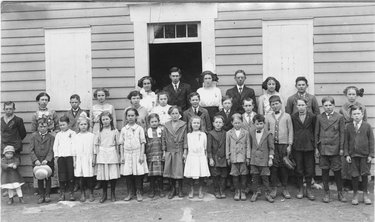Dear old Golden Rule days recalled by Knox Historical Society
— Photo courtesy of John Elberfeld
Grand opening: Daniel Driscoll, left, asks Pauline Williman, far right, about her school days at Knox District #5 during the opening of the restored building. Driscoll spearheaded the restoration project of the one-room schoolhouse at Emma Treadwell Thacher Nature Center.
— Photo courtesy of Edward.Hogan
Students of all ages and abilities learned together at Skunk’s Misery school in Knox District #3 in the early 1900s. Several former students from one-room-schoolhouses will share memories at Knox Historical Society’s program on Sunday, Aug. 25, from 2 to 4 p.m., in the Knox Town Hall.
What was school like when grades one through eight were in the same classroom? Why did students walk several miles to school? Was it sanitary to share a dipper and drink out of a communal bucket?
Schoolmarm Toni Lasher will re-create life in the one-room schoolhouse at the Knox Historical Society’s final summer program on Sunday, Aug. 25, from 2 to 4 p.m.
The event will be held in the Knox Town Hall (2192 Berne-Altamont Road), behind the society’s Saddlemire Homestead Museum. The town hall is barrier-free, accessible to people with handicaps.
Several former students of one-room schools will be on hand to recall their experiences. Children and their families are invited to participate in the interactive school day. The museum will also be open for self-guided tours. Refreshments will be served.
The earliest schools in Knox were simple, crude log buildings with local clergymen or traveling teachers as educators. By the 1880s, Knox had 13 school districts, and the buildings had evolved in to the one-room schoolhouses we know today. The teacher was responsible for educating children ages 6 to 16 in a wide variety of subjects.
Parents seeking further education paid tuition for their children at public or private secondary schools, such as Knoxville Academy, which operated in Knox from 1840 to 1869. Considered one of the finest educational facilities in Albany County, it attracted students from the surrounding cities, preparing them for entrance into college, business, or teaching.
The Berne-Knox Central School District was formed in 1932. Over the next two decades, Knox’s one-room schoolhouses closed as students transferred to the central school in Berne. The small buildings became houses, garages, sheds, or fire stations.
School #5 on Ketcham Road was later used as a dwelling and a clubhouse. Daniel Driscoll spearheaded efforts to restore the deteriorating building, its woodshed, and grounds, with labor and materials provided by Kiwanis Club of the Helderbergs and community members.
The schoolhouse re-opened in 2009 and is the only building in Knox on the National Register of Historic Places. It is part of the Emma Treadwell Thacher Nature Center and is open for special programs and by appointment. Contact the center at 872-0800 for more information.
The Knox Historical Society meets the first Tuesday of the month at 7 p.m. at the Knox Town Hall. All meetings are open to the public, and new members are always welcome. Call John Elberfeld or me at 872-2082 for more information. To learn more about Knox school districts, visit www.AlbanyHilltowns.com
Editor’s note: Jane McLean is the vice president of the Knox Historical Society.


